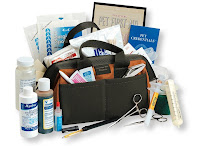 Some dogs are quiet while others can throw the house into a tizzy with their vociferous barking. Although we love our buddies dearly, sometimes this breach of discipline, can confound and exasperate us all.
Some dogs are quiet while others can throw the house into a tizzy with their vociferous barking. Although we love our buddies dearly, sometimes this breach of discipline, can confound and exasperate us all.
So, here’s a quick checklist that can actually help you abate the menace:
1. You have to first make sure you are providing your pet with all the necessities. If you are not paying adequate attention, he may try to communicate his frustration through barking. Sometimes, flea or tick infestations and skin allergies can spark irritation resulting in abrupt behavioral change on your dog’s part. If his hunger or thirst remains unfulfilled he may also react in a similar manner. So, you can actually help him get rid of this unruly behavior by taking care of all his needs. Moreover, you can also take him to a veterinarian to rule out canine diseases.
2. When he barks excessively take him out in the open. Play with him and also let him play with other dogs. You can also uplift his mood by making him do light exercises. This would help in stimulating both his mind and body.
Finally, remember that every dog craves for attention. So, never reprimand him. Instead try to be as gentle and polite with him as possible. You can actually help him overcome this problem by showering love and praises on him. But if he still continues to behave strangely take him to a vet at the earliest.
Tuesday, November 10, 2009
Get rid of your pet’s limitless barking…
Posted by doglover at 11/10/2009 0 comments
Labels: causes of barking, tips to control barking
Thursday, November 5, 2009
First aid kit for your dog…
 Accidents can occur without warning. But we should have the preparedness to deal with these unforeseen circumstances by keeping a first aid box handy. But do you know what should a dog’s first aid kit contain?
Accidents can occur without warning. But we should have the preparedness to deal with these unforeseen circumstances by keeping a first aid box handy. But do you know what should a dog’s first aid kit contain?
Here’s a handy checklist:
1. Sterile gauze sponges of different sizes
2. Sterile cotton or cotton balls
3. A mild anti-bacterial soap for cleaning skin and wounds
4. Bandage scissors
5. Blunt-tipped scissors
6. Antiseptic ointment, powder or spray for wounds
7. Alcohol swabs (for instrument sterilization)
8. Rubbing alcohol
9. Adhesive tape for bandages
10. Rectal thermometer/Oral thermometer
11. Lubricating jelly to lubricate thermometer
12. Forceps or tweezers
13. Razor blade for snake bite
14. Hydrogen peroxide (to induce vomiting in case of non-caustic poison intake; give 10ml after every 15 minutes)
15. Eye wash
16. Ear syringe (used for flushing eyes, ears and wounds)
17. Instant hot as well as cold compresses
18. Kaopectate tablets
19. Pepto-Bismol
20. Large exam quality vinyl gloves or latex gloves
21. Burn relief gel pack
22. Insect sting relief pads
23. Buffered analgesic, antipyretic and anti-inflammatory medication
24. Oral syringes
25. Large towel
26. Leash
27. Muzzle
28. Dog’s health record and medication
29. Regular veterinary and emergency clinic timings and numbers
30. Local and national poison control numbers
31. Gauze sponges (variety of sizes)
32. 2" gauze roll
33. Roll bandages - gauze wrap and elastic
34. Adhesive tape
35. Sponge
36. Sterile pads (non-adhesive) various sizes
37. Small rounded scissors
38. Nylon leash
39. Paper Towels
40. Thermal blanket or emergency blanket
41. Hand wash or wipes
42. Antibiotic cream or ointment
43. Saline eyewash
44. Epsom salt
45. Corn syrup or glucose paste
46. Clean cloth
47. Tourniquet or something to make one
48. Q-tips
49. Teaspoon
50. 3 Small garbage bags
51. Benadryl liquid and pills
52. Imodium AD
53. Activated charcoal
Posted by doglover at 11/05/2009 0 comments
Labels: first aid kit for dog, pet’s first aid kit
Tuesday, November 3, 2009
Glucosamine – Its role in pain relief...
As old age strikes, our pooches start exhibiting joint pain resulting from regenerative bone diseases like osteoarthritis, obesity, displasia, improper diet and too much exercise. But as dog parents we hate to see them in excruciating pain and hence try out all best possible means to give them succor. And one of the easiest and most effective means of doing that is by supplementing his diet with glucosamine. It is a compound found in the body of dogs which produces glycosaminoglycan, a molecule that helps in the formation and repair of cartilage and other body tissues. However, production of glucosamine slows down with age.
Arthritis or for that matter any regenerative joint disease may manifest itself by lingering pain or discomfort in movement. Larger breeds are far more susceptible to contracting arthritis than their smaller counterparts.
How will you take care of your pets under these circumstances?
- You have to ensure that his weight does not increase beyond a certain point and for maintaining that you must switch over to a nutritious, low calorie diet. This would help in minimizing impact on joints.
- As your pooch is already in pain excessive activities can be detrimental to his health. So, reduce his exercise to two or three daily walks.
- Supplement his diet with glucosamine. Its anti-inflammatory and joint rejuvenating qualities can actually alleviate the pain. Glucosamine has been found to yield beneficial results with minimal side effects.
Posted by doglover at 11/03/2009 0 comments
Labels: glucosamine in dog food, symptoms of arthritis in dogs, treatment of arthritis in dogs
